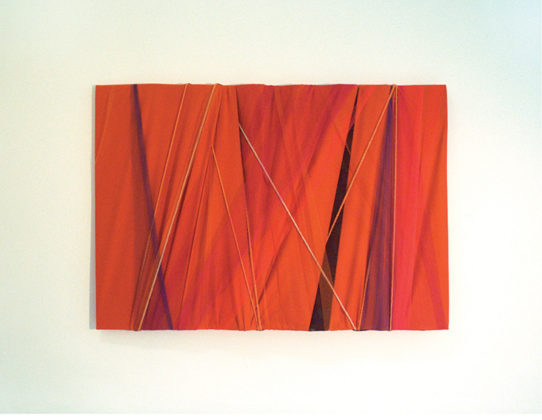
“Red Banners” by Archi Galentz
Artist Archi Galentz Marks a Half Century with What He Loves Best: Art
By Muriel Mirak-Weissbach
BERLIN, AUGUST 19, 2021— If you are an Armenian artist living in the German capital and you are about to turn 50, how should you celebrate the occasion?
Archi Galentz has decided to mark the event with an exhibition of a special kind.
Among the working titles he considered were “The First 50” and “Stages of Formation of the Midlife Crisis of an Arriereguardist,” but the show was not to be a retrospective. Another possible name was “My Spasm,” to indicate (the artist explains in a brochure prepared for the event) “the process of giving birth to this brainchild of mine in the form of a personal exhibition of my most important projects.”
But the final title chosen was “Private Club” — not an exhibition like others, but a discreet gathering, a private function for friends and associates to come together, because the moment is not like any others, and not only due to the pandemic. There is a broader context. Galentz writes that “it is inappropriate to celebrate loudly and brightly at the moment when your homeland self-destructs and dissolves in dreams of hidden potentials and obvious allies that can be revived by the magic spells of prehistoric ancestors.” This, however, is not the theme of the exhibition. Unlike previous shows, here there are no works with maps of Armenia, imaginary maps, or those of the historic homeland, no visions of a national republic. The context has changed. He feels fettered by the “complete bankruptcy of governance and, even worse, civil society and intellectual thought.” But, despite the lack of viable alternatives for building a new society, the artist refuses to turn the beautiful gallery into “a wailing wall.”
Instead, the friends and colleagues attending the birthday gathering will see eight projects from different creative periods still inhabiting Galentz’s thoughts and activity. They are works of the past but continue to live. One installation, “Survival Kit,” incorporates drawings and paintings by other artists, Achot Achot, Silvina Der Meguerditchian and Nishan Kazazyan. It was first shown at the Belgrade Museum of Contemporary Art in 2005 in an exhibition titled “Situated Self. Confused, Compassionate and Conflictual.” Another work, “Not Red Banners,” begun in 2003, studies the phenomenon of color transformations in silk fabrics in purple, orange and red, which oscillate depending on the viewer’s perspective. There are also photographic works, for example a 2002 printout of a “Distant View on Kremlin,” one of a series of images of the city made through a camera oscura. A smaller room hosts figurative compositions (“Painting is the queen of visual arts,” writes Galentz), and they include mystical compositions referencing antiquity. “The Flaying of Marsyas” is a piece he has been working on for six years.
Archi Galentz was born in 1971 in Moscow, into a family of Armenian artists. After attending schools in the Russian capital, he entered the State University of Arts and Theater in Yerevan and three years later began attending classes as a visiting student at the University of Arts in Berlin, then completed his studies for a master’s degree in 1997. His first solo show took place in Berlin in 2000 and since then he has been active as a freelance artist and curator. In 2008 he founded the artist-run space InteriorDAsein in Berlin, which has promoted cooperative art projects with Russia and Armenia, and, with Andreas Wolf, co-founded Wolf & Galentz gallery there in 2019. In 2012 he received the Arshile Gorky medal from the Armenian Ministry of Diaspora Affairs. He has taken part in over 80 group exhibitions, curated over 20 exhibitions since 2000 and held numerous solo shows.
At 50, Archi has remarked, one usually begins to look back in time. But he “feels like a beginner who’s dreaming of having his own atelier, so he can finally start painting.”
Best wishes for the next fifty!